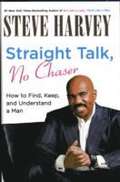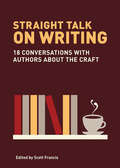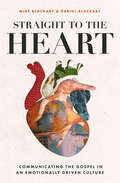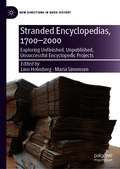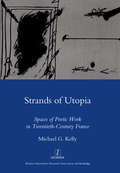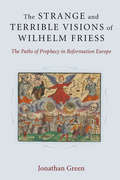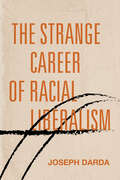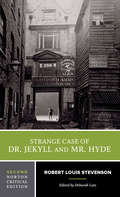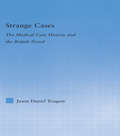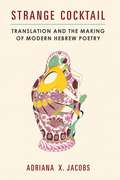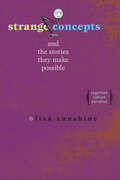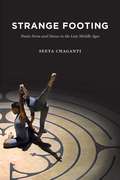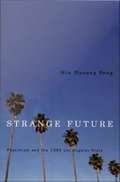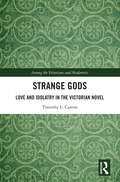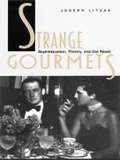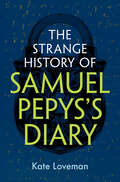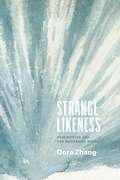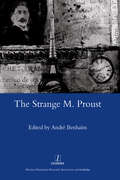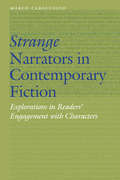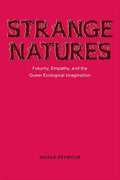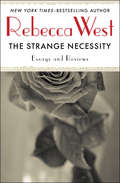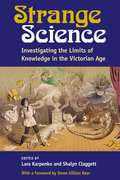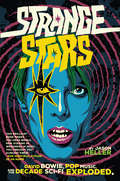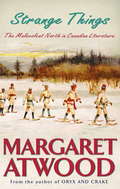- Table View
- List View
Straight Talk, No Chaser: How to Find, Keep, and Understand a Man
by Steve HarveyIn the instant number one New York Times bestseller Act Like a Lady, Think Like a Man, Steve Harvey gave millions of women around the globe insight into what men really think about love, intimacy, and commitment. In his new book he zeros in on what motivates men and provides tips on how women can use that knowledge to get more of what they need out of their relationships, whether it's more help around the house, more of the right kind of attention in the bedroom, more money in the joint bank account, or more truth when it comes to the hard questions, such as: Are you committed to building a future together? Does my success intimidate you? Have you cheated on me? In Straight Talk, No Chaser: How to Find, Keep, and Understand a Man, Steve Harvey shares information on: How to Get the Truth Out of Your Man * Tired of answers that are deceptive? Harvey lays out a three-tier, CIA-style of questioning that will leave your man no choice but to cut to the chase and deliver the truth. Dating Tips, Decade by Decade * Whether you're in your twenties and just starting to date seriously, in your thirties and feeling the tick of the biological clock, or in your forties and beyond, Steve provides insight into what a man, in each decade of his life, is looking for in a mate. How to Minimize Nagging and Maximize Harmony at Home * He said he'd cut the lawn on Saturday, and you may have been within reason to think that that meant Saturday before ten in the evening, but exploding at him is only going to ruin the mood for everyone, which means no romance. Steve shows you how to talk to your man in a way that moves him to action and keeps the peace. And there's much more, including Steve's candid answers to questions you've always wanted to ask men. Drawing on a lifetime of experience and the feedback women have shared with him in reaction to Act Like a Lady, Think Like a Man, Harvey offers wisdom on a wealth of topics relevant to both sexes today. He also gets more personal, sharing anecdotes from his own family history. Always direct, often funny, and incredibly perceptive, media personality, comedian, philanthropist, and (finally) happily married husband, Steve Harvey proves once again that he is the king of relationships.
Straight Talk on Writing: 20 Conversations with Authors about the Craft
by Scott FrancisThis compelling book provides you with eighteen insightful interviews with bestselling authors, writing instructors, agents, award-winning writers and more. Youll learn how to create characters, plot more effectively, live the writers life with purpose and abandon, and much more. Interviewees include Orson Scott Card, George Singleton, Donald Maass, Dinty Moore, Peter Selgin, James Alexander Thom, and many more. The interviews are casual, relaxed, revealing and instructive. Dig in
Straight to the Heart: Communicating the Gospel in an Emotionally Driven Culture
by Daniel Blackaby Mike BlackabyOur approach to apologetics needs to change when the very idea of &“truth&” is controversial. But as authors Daniel Blackaby and Mike Blackaby teach us, we can still reach people if we understand what they value most. This practical guide to our current landscape explores five effective communication pathways: Story: As people wired for narrative, we can speak through the stories we live and tell. Beauty: In an increasingly industrialized world, we can point people to &“pockets of beauty&” that reveal the attractiveness of God. Art: In a society that celebrates the arts, we can cultivate creativity in the church, then send artists out as cultural missionaries. Desire: To a people motivated by love, identity, and purpose, we can show how Jesus is the perfect fulfillment of our deepest longings.Community: As relational creatures where connectivity is disappearing, we can offer a community of unified diversity. Culture may be in flux, but God&’s Word remains true. Straight to the Heart helps us speak to the passions that drive our culture without compromising the life-changing truth of the gospel.
Stranded Encyclopedias, 1700–2000: Exploring Unfinished, Unpublished, Unsuccessful Encyclopedic Projects (New Directions in Book History)
by Linn Holmberg Maria SimonsenIn Stranded Encyclopedias, 1700–2000: Exploring Unfinished, Unpublished, Unsuccessful Encyclopedic Projects, fourteen scholars turn to the archives to challenge the way the history of modern encyclopedism has long been told. Rather than emphasizing successful publications and famous compilers, they explore encyclopedic enterprises that somehow failed. With a combined attention to script, print, and digital cultures, the volume highlights the many challenges facing those who have pursued complete knowledge in the past three hundred years. By introducing the concepts of stranded and strandedness, it also provides an analytical framework for approaching aspects often overlooked in histories of encyclopedias, books, and learning: the unpublished, the unfinished, the incomplete, the unsuccessfully disseminated, and the no-longer-updated. By examining these aspects in a new and original way, this book will be of value to anyone interested in the history of encyclopedism and lexicography, the history of knowledge, language, and ideas, and the history of books, writing, translating, and publishing. Chapters 1 and 4 are available open access under a Creative Commons Attribution 4.0 International License via link.springer.com.
Strands of Utopia: Spaces of Poetic Work in Twentieth Century France
by Michael G Kelly"The poetic is an abiding yet elusive qualification within the discursive system of twentieth-century French literature. No longer amenable to formal assignment, its recurrences delimit a shifting, multi-layered practice of artistic and intellectual (self-) invention. This study attempts to outline certain durable properties of that practice by confronting it with the complex theoretical and spatial metaphor of utopia. Drawing, in particular, upon the oeuvres of Victor Segalen (1878-1919), Rene Daumal (1908-44) and Yves Bonnefoy (b. 1923), it traces poetic work - work done in support of poetic difference - along the social, physical and textual axes of what is argued to be a sustained and radically inclusive utopian practice within the literary field. The complex utopian quality of poetic work is linked to the cultural persistence of the poetic as a simple attribute within literary practice. In uncovering this link, the study encourages revised understandings of both the poetic and the utopian in the modern French literary context."
The Strange and Terrible Visions of Wilhelm Friess: The Paths of Prophecy in Reformation Europe
by Jonathan GreenAlthough nearly forgotten today, the prophetic writing of Wilhelm Friess was the most popular work of its kind in Germany in the second half of the sixteenth century. While the author "Wilhelm Friess" was a convenient fiction, his text had a long and remarkable history as it moved from the papal court in fourteenth-century Avignon, to Antwerp under Habsburg oppression, to Nuremberg as it was still reeling from Lutheran failures in the Schmalkaldic War, and then back to Antwerp at the outbreak of the Dutch revolt. Dutch scholars have recognized that Frans Fraet was executed for printing a prognostication by Willem de Vriese, but this prognostication was thought to be lost. A few scholars of sixteenth-century German apocalypticism have briefly noted the prophecies of Wilhelm Friess but have not studied them in depth. The Strange and Terrible Visions of Wilhelm Friess is the first to connect de Vriese and Friess, as well as recognize the prophecy of Wilhelm Friess as an adaptation of a French version of theVademecum of Johannes de Rupescissa, making these pamphlets by far the most widespread source for Rupescissa's apocalyptic thought in Reformation Germany. The book explains the connection between the first and second prophecies of Wilhelm Friess and discovers the Calvinist context of the second prophecy and its connection to Johann Fischart, one of the most important German writers of the time. Jonathan Green provides a study of how textual history interacts with print history in early modern pamphlets and proposes a model of how early modern prophecies were created and transmitted. The Strange and Terrible Visions of Wilhelm Friess makes important contributions to the study of early modern German and Dutch literature, apocalypticism and confessionalization during the Reformation, and the history of printing in the sixteenth century.
The Strange Career of Racial Liberalism (Post*45)
by Joseph DardaHow Americans learned to wait on time for racial change What if, Joseph Darda asks, our desire to solve racism—with science, civil rights, antiracist literature, integration, and color blindness—has entrenched it further? In The Strange Career of Racial Liberalism, he traces the rise of liberal antiracism, showing how reformers' faith in time, in the moral arc of the universe, has undercut future movements with the insistence that racism constitutes a time-limited crisis to be solved with time-limited remedies. Most historians attribute the shortcomings of the civil rights era to a conservative backlash or to the fracturing of the liberal establishment in the late 1960s, but the civil rights movement also faced resistance from a liberal "frontlash," from antiredistributive allies who, before it ever took off, constrained what the movement could demand and how it could demand it. Telling the stories of Ruth Benedict, Kenneth Clark, W. E. B. Du Bois, John Howard Griffin, Pauli Murray, Lillian Smith, Richard Wright, and others, Darda reveals how Americans learned to wait on time for racial change and the enduring harm of that trust in the clock.
The Strange Case of Dr. Jekyll and Mr. Hyde (Norton Critical Editions #0)
by Robert Louis Stevenson“The annotations are useful, particularly for references to biblical and other literary allusions. [The contexts] section is essential to alerting students to the many subtexts/contexts of the story.” —MARIA CARRIG, Carthage College This Norton Critical Edition includes: The first British edition of the novel, published in 1886 by Longmans, Green, and Co., the only edition set directly from Stevenson’s manuscript and for which he read and corrected proofs. Deborah Lutz’s thorough introduction and detailed explanatory footnotes to the novel. Seven illustrations. A rich and relevant selection of background materials centered on the novel’s composition, reception, and historical and cultural contexts, alongside seven of Stevenson’s letters. Interpretative essays by Elaine Showalter, Jack Halberstam, Martin Danahay, and Stephen Arata. A chronology and a selected bibliography. About the Series Read by more than 12 million students over fifty-five years, Norton Critical Editions set the standard for apparatus that is right for undergraduate readers. The three-part format—annotated text, contexts, and criticism—helps students to better understand, analyze, and appreciate the literature, while opening a wide range of teaching possibilities for instructors. Whether in print or in digital format, Norton Critical Editions provide all the resources students need.
Strange Cases: The Medical Case History and the British Novel (Literary Criticism and Cultural Theory)
by Jason TougawStrange Cases is the story of the mutual influence of the case history and the British novel during the eighteenth and nineteenth centuries. Fictions from Defoe's Roxana to James's The Turn of the Screw and case histories from George Cheyne's to Sigmund Freud's have found narrative impetus in pathology. The writer of a case history faces a rhetorical bind unique to the human sciences: the need to display the acumen of a scientist and the sympathy warranted to the suffering patient. Repeatedly, case historians justify their publicizing of extreme, often morbid or perverse, states of mind and body by appealing to readers to take pity on patients and to recognize the narrative as a vital social document. Diagnosis and sympathy, explicit rhetorical modes in case histories, operate implicitly in novels, shaping reader-identification. While these two narrative forms set out to fulfill an Enlightenment drive to classify and explain, they also raise social and epistemological questions that challenge some of the Enlightenment's most cherished ideals, including faith in reason, the perfectibility of humankind, and the stability of truth.
Strange Cocktail: Translation and the Making of Modern Hebrew Poetry (Michigan Studies In Comparative Jewish Cultures)
by Adriana X. JacobsFor centuries, poets have turned to translation for creative inspiration. Through and in translation, poets have introduced new poetic styles, languages, and forms into their own writing, sometimes changing the course of literary history in the process. Strange Cocktail is the first comprehensive study of this phenomenon in modern Hebrew literature of the late nineteenth century to the present day. Its chapters on Esther Raab, Leah Goldberg, Avot Yeshurun, and Harold Schimmel offer close readings that examine the distinct poetics of translation that emerge from reciprocal practices of writing and translating. Working in a minor literary vernacular, the translation strategies that these poets employed allowed them to create and participate in transnational and multilingual poetic networks. Strange Cocktail thereby advances a comparative and multilingual reframing of modern Hebrew literature that considers how canons change and are undone when translation occupies a central position—how lines of influence and affiliation are redrawn and literary historiographies are revised when the work of translation occupies the same status as an original text, when translating and writing go hand in hand.
Strange Concepts and the Stories They Make Possible: Cognition, Culture, Narrative
by Lisa ZunshineIn this fresh and often playful interdisciplinary study, Lisa Zunshine presents a fluid discussion of how key concepts from cognitive science complicate our cultural interpretations of "strange" literary phenomena.From Short Circuit to I, Robot, from The Parent Trap to Big Business, fantastic tales of rebellious robots, animated artifacts, and twins mistaken for each other are a permanent fixture in popular culture and have been since antiquity. Why do these strange concepts captivate the human imagination so thoroughly? Zunshine explores how cognitive science, specifically its ideas of essentialism and functionalism, combined with historical and cultural analysis, can help us understand why we find such literary phenomena so fascinating.Drawing from research by such cognitive evolutionary anthropologists and psychologists as Scott Atran, Paul Bloom, Pascal Boyer, and Susan A. Gelman, Zunshine examines the cognitive origins of the distinction between essence and function and how unexpected tensions between these two concepts are brought into play in fictional narratives. Discussing motifs of confused identity and of twins in drama, science fiction’s use of robots, cyborgs, and androids, and nonsense poetry and surrealist art, she reveals the range and power of key concepts from science in literary interpretation and provides insight into how cognitive-evolutionary research on essentialism can be used to study fiction as well as everyday strange concepts.
Strange Footing: Poetic Form and Dance in the Late Middle Ages
by Seeta ChagantiFor premodern audiences, poetic form did not exist solely as meter, stanzas, or rhyme scheme. Rather, the form of a poem emerged as an experience, one generated when an audience immersed in a culture of dance encountered a poetic text. Exploring the complex relationship between medieval dance and medieval poetry, Strange Footing argues that the intersection of texts and dance produced an experience of poetic form based in disorientation, asymmetry, and even misstep. Medieval dance guided audiences to approach poetry not in terms of the body’s regular marking of time and space, but rather in the irregular and surprising forces of virtual motion around, ahead of, and behind the dancing body. Reading medieval poems through artworks, paintings, and sculptures depicting dance, Seeta Chaganti illuminates texts that have long eluded our full understanding, inviting us to inhabit their strange footings askew of conventional space and time.Strange Footing deploys the motion of dance to change how we read medieval poetry, generating a new theory of poetic form for medieval studies and beyond.
Strange Future: Pessimism and the 1992 Los Angeles Riots
by Min Hyoung SongSometime near the start of the 1990s, the future became a place of national decline. The United States had entered a period of great anxiety fueled by the shrinking of the white middle class, the increasingly visible misery of poor urban blacks, and the mass immigration of nonwhites. Perhaps more than any other event marking the passage through these dark years, the 1992 Los Angeles riots have sparked imaginative and critical works reacting to this profound pessimism. Focusing on a wide range of these creative works, Min Hyoung Song shows how the L. A. riots have become a cultural-literary event--an important reference and resource for imagining the social problems plaguing the United States and its possible futures. Song considers works that address the riots and often the traumatic place of the Korean American community within them: the independent documentary Sa-I-Gu (Korean for April 29, the date the riots began), Chang-rae Lee's novel Native Speaker, the commercial film Strange Days, and the experimental drama of Anna Deavere Smith, among many others. He describes how cultural producers have used the riots to examine the narrative of national decline, manipulating language and visual elements, borrowing and refashioning familiar tropes, and, perhaps most significantly, repeatedly turning to metaphors of bodily suffering to convey a sense of an unraveling social fabric. Song argues that these aesthetic experiments offer ways of revisiting the traumas of the past in order to imagine more survivable futures.
Strange Gods: Love and Idolatry in the Victorian Novel (Among the Victorians and Modernists)
by Timothy L. CarensDespite frequent declarations of the sanctity of love and marriage, British Protestant culture nurtured the fear that human affection might easily slip into idolatry. Throughout the nineteenth-century, theological essays, sermons, hymns, and didactic fiction and poetry urged the faithful to maintain a constant watch over their hearts, lest they become engrossed by human love, guilty of worshipping the creature rather than the Creator. Strange Gods: Love and Idolatry in the Victorian Novel traces the concerns produced in Protestant culture by this broad interpretation of idolatry. In chapters focusing on Charles Kingsley and Charlotte Brontë, Mary Elizabeth Braddon, George Eliot, Oscar Wilde, and Thomas Hardy, this volume shows that even supposedly secular novels obsessively reenact an ideological clash between Protestant faith and human love. Anxiety about adoring humans more than God frequently overshadows and sometimes derails the progress of romance in Victorian novels. By probing this anxiety and its narrative effects, Strange Gods uncovers how a central Protestant belief exerts its influence over stories about love and marriage.
Strange Gourmets: Sophistication, Theory, and the Novel
by Joseph LitvakTheoretically sophisticated: How often has this term been used to distinguish a work of contemporary criticism, and what, exactly, does it mean? In Strange Gourmets, Joseph Litvak reclaims sophistication from its negative connotations and turns the spotlight on those who, even as they demonize sophistication, surreptitiously and extensively use it.Though commonly thought of as a kind of worldliness at its best and an elitist snobbery at its worst, sophistication, Litvak reminds us, remains tied to its earlier, if forgotten, meaning of "perversion"--a perversion whose avatars are the homosexual and the intellectual. Proceeding with his investigations from a specifically gay academic perspective, Litvak presents thoroughly inventive readings of novels by Austen, Thackeray, and Proust, and of theoretical works by Adorno and Barthes, each text epitomizing sophistication in one of its more familiar modes. Among the issues he explores are the ways in which these texts teach sophistication, the embarrassment that sophistication causes the sophisticated, and how the class politics of sophistication are inseparable from its sexual politics. Helping gay, queer, feminist, and other provocative critics to make the most of their bad publicity, Litvak mindfully celebrates sophistication's economy of taste and pleasure.
The Strange History of Samuel Pepys's Diary
by Kate LovemanDuring the 1660s, Samuel Pepys kept a secret diary full of intimate details and political scandal. Had the contents been revealed, they could have destroyed his marriage, ended his career, and seen him arrested. This engaging book explores the creation of the most famous journal in the English language, how it came to be published in 1825, and the many remarkable roles it has played in British culture since then. Kate Loveman – one of the few people who can read Pepys's shorthand – unlocks the riddles of the diary, investigating why he chose to preserve such private matters for later generations. She also casts fresh light on the women and sexual relationships in Pepys's life and on Black Britons living in or near his household. Exploring the many inventive uses to which the diary has been put, Loveman shows how Pepys's history became part of the history of the nation.
Strange Likeness: Description and the Modernist Novel (Thinking Literature)
by Dora ZhangThe modern novel, so the story goes, thinks poorly of mere description—what Virginia Woolf called “that ugly, that clumsy, that incongruous tool.” As a result, critics have largely neglected description as a feature of novelistic innovation during the twentieth century. Dora Zhang argues that descriptive practices were in fact a crucial site of attention and experimentation for a number of early modernist writers, centrally Woolf, Henry James, and Marcel Proust. Description is the novelistic technique charged with establishing a common world, but in the early twentieth century, there was little agreement about how a common world could be known and represented. Zhang argues that the protagonists in her study responded by shifting description away from visualizing objects to revealing relations—social, formal, and experiential—between disparate phenomena. In addition to shedding new light on some of the best-known works of modernism, Zhang opens up new ways of thinking about description more broadly. She moves us beyond the classic binary of narrate-or-describe and reinvigorates our thinking about the novel. Strange Likeness will enliven conversations around narrative theory, affect theory, philosophy and literature, and reading practices in the academy.
The Strange M. Proust
by Andre BenhaimThe strange M. Proust - the narrator, the author, and the embodiment of A la Recherche du Temps perdu - is now so canonical a writer that his very strangeness is easily overlooked. His book made of other books, his epic composed of extraordinary miniatures, his orderly structure where every law is subverted, his chronology where time can be undone and his geography where places can superimpose: in these, and many other ways, Proust continues to astonish even readers who have engaged with him for their entire careers. In this book, arising from the Princeton symposium of 2006, major critics come together to offer provocative readings of a work which is at the same time classical and unusual, French and foreign, familiar and strange. The book is dedicated to the memory of Malcolm Bowie (1943-2007), whose keynote address was one of his last major lectures. Other contributors include David Ellison, Anne Simon, Eugene Nicole, Joseph Brami, Raymonde Coudert, Christie McDonald, Michael Wood and Antoine Compagnon.
Strange Narrators in Contemporary Fiction: Explorations in Readers' Engagement with Characters (Frontiers of Narrative)
by Marco CaraccioloA storyteller’s craft can often be judged by how convincingly the narrative captures the identity and personality of its characters. In this book, the characters who take center stage are “strange” first-person narrators: they are fascinating because of how they are at odds with what the reader would wish or expect to hear—while remaining reassuringly familiar in voice, interactions, and conversations. Combining literary analysis with research in cognitive and social psychology, Marco Caracciolo focuses on readers’ encounters with the “strange” narrators of ten contemporary novels, including Bret Easton Ellis’s American Psycho, Haruki Murakami’s Hard-Boiled Wonderland and the End of the World, and Mark Haddon’s The Curious Incident of the Dog in the Night-Time. Caracciolo explores readers’ responses to narrators who suffer from neurocognitive or developmental disorders, who are mentally disturbed due to multiple personality disorder or psychopathy, whose consciousness is split between two parallel dimensions or is disembodied, who are animals, or who lose their sanity. A foray into current work on reception, reader-response, cognitive literary study, and narratology, Strange Narrators in Contemporary Fiction illustrates why any encounter with a fictional text is a complex negotiation of interlaced feelings, thoughts, experiences, and interpretations.
Strange Natures: Futurity, Empathy, and the Queer Ecological Imagination
by Nicole SeymourIn Strange Natures, Nicole Seymour investigates the ways in which contemporary queer fictions offer insight on environmental issues through their performance of a specifically queer understanding of nature, the nonhuman, and environmental degradation. By drawing upon queer theory and ecocriticism, Seymour examines how contemporary queer fictions extend their critique of "natural" categories of gender and sexuality to the nonhuman natural world, thus constructing a queer environmentalism. Seymour's thoughtful analyses of works such as Leslie Feinberg's Stone Butch Blues, Todd Haynes's Safe, and Ang Lee's Brokeback Mountain illustrate how homophobia, classism, racism, sexism, and xenophobia inform dominant views of the environment and help to justify its exploitation. Calling for a queer environmental ethics, she delineates the discourses that have worked to prevent such an ethics and argues for a concept of queerness that is attuned to environmentalism's urgent futurity, and an environmentalism that is attuned to queer sensibilities.
The Strange Necessity: Essays and Reviews (Virago Modern Classics Ser. #2313)
by Rebecca WestIn this intellectually challenging collection of literary criticism, Rebecca West undertakes the question of art&’s value, examining the works of her contemporaries and their places in history &“The Strange Necessity,&” one of the twelve essays collected here and first published in 1928, anchors West&’s quest to understand why art matters and how aesthetics of every caliber can not only inspire but reveal the author&’s inner world. Whether juxtaposing Ulysses&’s prose with Pavlov&’s research, or comparing Sinclair Lewis with actress and pianist Yvonne Printemps, West finds that a satisfying emotion overrides an artistic work&’s form. Her intricately crafted essays reveal her experience in the literary circles of the twenties and thirties and the important role this question played in her own writing. West&’s keenly observed criticism offers invaluable insight not only into her work but into her impressions of early twentieth century literature.
Strange Science: Investigating the Limits of Knowledge in the Victorian Age
by Lara Pauline Karpenko Shalyn Rae ClaggettThe essays in Strange Science examine marginal, fringe, and unconventional forms of scientific inquiry, as well as their cultural representations, in the Victorian period. Although now relegated to the category of the pseudoscientific, fields like mesmerism and psychical research captured the imagination of the Victorian public. Conversely, many branches of science now viewed as uncontroversial, such as physics and botany, were often associated with unorthodox methods of inquiry. Whether ultimately incorporated into mainstream scientific thought or categorized by 21st century historians as pseudo- or even anti-scientific, these sciences generated conversation, enthusiasm, and controversy within Victorian society. To date, scholarship addressing Victorian pseudoscience tends to focus either on a particular popular science within its social context or on how mainstream scientific practice distinguished itself from more contested forms. Strange Science takes a different approach by placing a range of sciences in conversation with one another and examining the similar unconventional methods of inquiry adopted by both now-established scientific fields and their marginalized counterparts during the Victorian period. In doing so, Strange Science reveals the degree to which scientific discourse of this period was radically speculative, frequently attempting to challenge or extend the apparent boundaries of the natural world. This interdisciplinary collection will appeal to scholars in the fields of Victorian literature, cultural studies, the history of the body, and the history of science.
Strange Stars: How Science Fiction and Fantasy Transformed Popular Music
by Jason HellerA Hugo Award-winning author and music journalist explores the weird and wild story of when rock ’n’ roll met the sci-fi world of the 1970sAs the 1960s drew to a close, and mankind trained its telescopes on other worlds, old conventions gave way to a new kind of hedonistic freedom that celebrated sex, drugs, and rock ’n’ roll. Derided as nerdy or dismissed as fluff, science fiction rarely gets credit for its catalyzing effect on this revolution.In Strange Stars, Jason Heller recasts sci-fi and pop music as parallel cultural forces that depended on one another to expand the horizons of books, music, and out-of-this-world imagery.In doing so, he presents a whole generation of revered musicians as the sci-fi-obsessed conjurers they really were: from Sun Ra lecturing on the black man in the cosmos, to Pink Floyd jamming live over the broadcast of the Apollo 11 moon landing; from a wave of Star Wars disco chart toppers and synthesiser-wielding post-punks, to Jimi Hendrix distilling the “purplish haze” he discovered in a pulp novel into psychedelic song. Of course, the whole scene was led by David Bowie, who hid in the balcony of a movie theater to watch 2001: A Space Odyssey, and came out a changed man…If today’s culture of Comic Con fanatics, superhero blockbusters, and classic sci-fi reboots has us thinking that the nerds have won at last, Strange Stars brings to life an era of unparalleled and unearthly creativity—in magazines, novels, films, records, and concerts—to point out that the nerds have been winning all along.
Strange Things: The Malevolent North in Canadian Literature
by Margaret AtwoodMargaret Atwood's witty and informative book focuses on the imaginative mystique of the wilderness of the Canadian North. She discusses the 'Grey Owl Syndrome' of white writers going native; the folklore arising from the mysterious-- and disastrous -- Franklin expedition of the nineteenth century; the myth of the dreaded snow monster, the Wendigo; the relations between nature writing and new forms of Gothic; and how a fresh generation of women writers in Canada have adapted the imagery of the Canadian North for the exploration of contemporary themes of gender, the family and sexuality. Writers discussed include Robert Service, Robertson Davies, Alice Munro, E.J. Pratt, Marian Engel, Margaret Laurence, and Gwendolyn MacEwan.This superbly written and compelling portrait of the mysterious North is at once a fascinating insight into the Canadian imagination, and an exciting new work from an outstanding literary presence.
Strange Truths in Undiscovered Lands
by Nahoko Miyamoto AlveyThe great Romantic poet Percy Bysshe Shelley had a complicated relationship with the British Empire and the culture of colonialism. Considered politically radical and scandalous in Britain, Shelley lived in self-imposed exile and set much of his writing in foreign places. In Strange Truths in Undiscovered Lands Nahoko Miyamoto Alvey examines the ways in which Shelley developed a 'Romantic geography' to provide visionary alternatives to an earth devastated by a new type of European colonialism and global expansion. Intertextually rich, Alvey's work establishes the context in which poems by Shelley and other Romantics were written by presenting relevant histories, travel texts, scientific writings, and archival material, and are all complemented by postcolonial analysis. Unique in its emphasis on the optimistic and positive aspects of Shelley's poetical works, Strange Truths in Undiscovered Lands offers a different perspective on Romantic Orientalism, and a new look at how the poet imagined the relationship between the Self and the Other. Thorough and original, this book will be of interest to Romanticists, postcolonialists, and anyone interested in alternative responses to acts of colonialism and empire.
